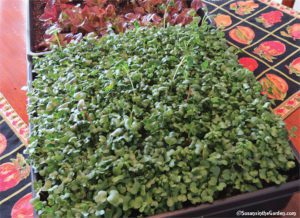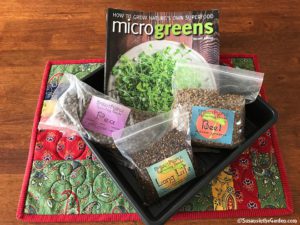Sept. 17 Column: How to Grow Microgreens

I’ve been looking forward to writing today’s column because it’s all about how to grow microgreens. What, you haven’t heard of them? Or you’ve heard the term but didn’t know what they’re all about? My column will hopefully get you excited about embarking on a new phase of gardening! Here’s a link to it: Microgreens keep harvests going during winter. (or you can read my column lower in this post)
What are microgreens all about?
Here’s how microgreens work. You plant seeds very thickly in a seedling flat or other container. Then you harvest the resulting seedlings when they just have a true (mature) leaf or two. Would you believe microgreens have anywhere from 4 to 40 TIMES the nutrients of their mature counterparts? (this depends on the type of seeds you grow)
I grew microgreens for the first time last winter and didn’t have to buy any salad greens at all. In addition to being easy to grow them, it was great fun trying something new. We primarily used our microgreens for salads and enjoyed adding roasted beets, feta cheese and roasted nuts to them. You can also add them to other types of dishes.
This week’s “Everyone Can Grow A Garden!” video will also help you learn how to grow microgreens. In it, I go through the process step-by-step. So even if you didn’t have the opportunity to grow an actual vegetable garden, use this opportunity to start growing food indoors that you can enjoy while the snow is flying outside!
Last year, I reviewed a useful book by Fionna Hill, Microgreens: How to Grow Nature’s Super Food. You might want to read the review, especially if you feel like you’re looking for extra guidance.
If you have any questions, don’t hesitate to drop me a note at Susan@SusansintheGarden.com. And if you do decide to grow microgreens, I’d love to hear from you as well!
Garden column: How to Grow Microgreens
by Susan Mulvihill
Who says you can’t grow vegetables year-round in the Inland Northwest? It’s true we have a frost-free season of just about 120 days. But that doesn’t mean there aren’t options for continuing to put fresh, healthy produce on your table. And you can do this even in January.
Over the past few years, I’ve been growing cold-tolerant vegetable crops in a hoop house in my garden. Kale, corn salad (mache), claytonia (miner’s lettuce) and spinach have performed well for me. That is, until about the middle of last winter when we alternated between bitterly cold temperatures and heavy snowstorms. Even my super-hardy salad greens didn’t want anything to do with that.
Why grow microgreens?
Fortunately, I had started growing microgreens indoors in the fall and those got us through the entire winter without my having to buy a single head of lettuce. Intrigued?
Put simply, producing microgreens involves thickly sowing seeds in flats and harvesting them while they are young seedlings with some true (mature) leaves. They can be grown any time of the year — indoors or out — but for this region, indoors during the colder months of the year is a perfect way to supplement the food I grow and preserve during our regular garden season.
The best part of growing and eating microgreens is that they are packed with nutrients. A joint study done by the University of Maryland College of Agriculture and the U.S. Department of Agriculture determined that microgreens contain anywhere from four to 40 times more nutrients than the mature form of the plants.
How to grow microgreens, step by step:
I fill seedling flats with 2 inches of seed-starting mix or organic potting mix. Once the mix has been moistened and compressed a bit, I sprinkle seeds over the top, cover the flats with a clear plastic dome lid and place them under grow lights. A sunny windowsill is another option.
Most seeds germinate quickly — at which time you remove the clear lid — and the resulting plants are usually ready to be harvested within 10 to 14 days. Harvesting involves using scissors or a knife and essentially mowing down the seedlings above the surface of the soil.
Choosing seeds to grow as microgreens is half the fun. Buying them in bulk quantities keeps it economical. I went to the sproutpeople.org website to study their options, but you can also find seeds locally at Northwest Seed & Pet as well as online sources such as Johnny’s Selected Seeds (johnnyseeds.com), Eden Brothers (edenbrothers.com) and High Mowing Organic Seeds (highmowingseeds.com).
Last winter, I grew sunflowers, brassica mixes (cabbage family crops), lettuce, peas and beets and everything was delicious. In fact, it was so simple, I’ve been wondering why I haven’t tried it sooner.
Here’s what I’ve learned:
- Most types of seeds do not need to be covered with seed-starting mix, so I just sprinkled the seeds thickly onto the mix and pressed them into it. The only seeds that seemed to grow better by being covered were the peas.
- It’s possible to use the cut-and-come-again harvesting method for lettuce to get multiple pickings from a single sowing.
- Sunflower seedlings should be harvested before they get their true leaves, which are hairy and bitter.
- Harvested microgreens last best when rinsed with water, gently tossed in a salad spinner and stored in the refrigerator.
A good reference guide to growing microgreens is “Microgreens: How to Grow Nature’s Own Superfood” (Firefly Books, 120 pp., $19.95) by Fionna Hill.


